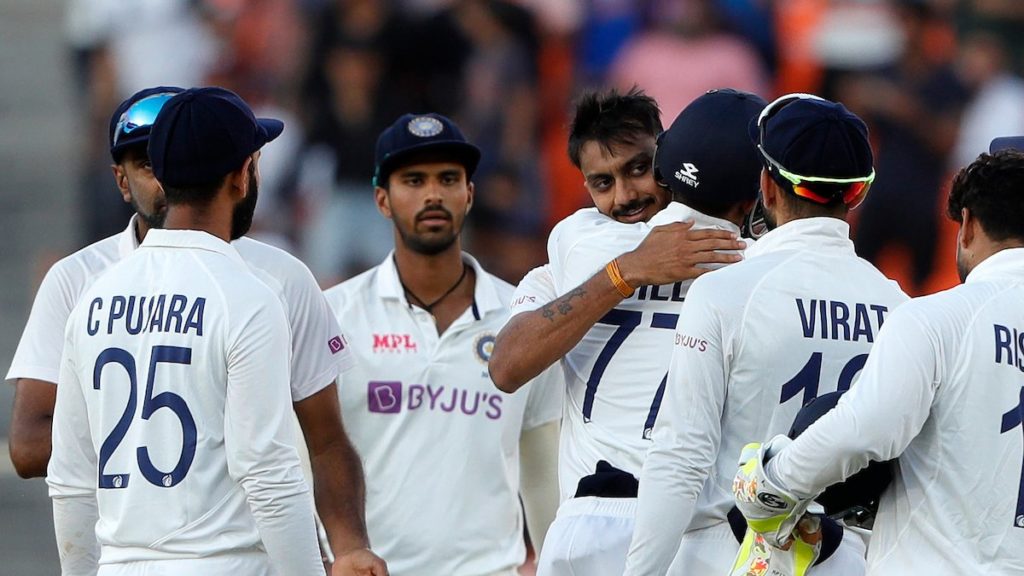India beat England by 10 wickets on day two of a Test match that will be remembered for being utterly dominated by spin bowling, reports SA Cricket magazine editor Ryan Vrede.
It didn’t even go the full two days. In fact, it lasted around 139 overs, it’s brevity entirely down to an Ahmedabad pitch that was a gift from the cricket gods to the spinners involved. To drive home just how rare what happened on Thursday is – this was just the eighth two-day Test since the end of World War II.
Furthermore: this, remember, was supposed to be a Test during which the seamers, strapped with the hooping pink ball, were expected to exhibit their talents at twilight.
Instead, 19 of England’s 20 wickets fell to spin – and 11 of those 19 to India’s new star, Axar Patel. The tourists simply had no comprehensive responses to the questions he asked.
His talent overwhelmed some of the world’s best batsmen. He dismissed Johnny Bairstow twice and also accounted for Joe Root and Ben Stokes.
Indeed, he completely cleaned up the England top four in the second dig, setting in motion a collapse that culminated in England being bowled out for under 200 for the fifth successive innings – only the second time in their history this has happened, and the first time since 1888.
Only a handful of England batsmen looked like they had a plan to counter the spin. None had an effective plan. The ball was certainly turning and bouncing, but it is lazy thinking – and would be a clear denial of the observable – to attribute all the blame to the Ahmedabad wicket.
There’ll be an inquest into the state of the Ahmedabad pitch in the coming days. The ICC Pitch and Outfield Monitoring Process is available on the ICC website and explains ‘poor’ as: ‘A “poor” pitch is one that does not allow an even contest between bat and ball,’ it says, ‘either by favouring the batters too much, and not giving the bowlers [seam and spin] from either team sufficient opportunity to take wickets, or by favouring the bowlers too much [seam or spin], and not giving the batters from either team the opportunity to make runs.’
Considering England’s deep struggles, and that India went from 98-3 overnight to 145 all out – with the unlikely figure of Joe Root at the heart of their demise with a return of 6.2-8-5 – there may be a case in theory for a poor pitch. However, those wickets that fell to spin need to be closely examined. One will find a fair share of them down to misjudgement, poor technique or rushes of blood to the head resulting in wild swings.
After Root, supported by Jack Leach (20-54-4), made quick work of India, England trailed by 33 runs. There was an immediate taste of what was to come when Patel dismissed Zak Crawley with the first delivery of the innings, getting the ball to spin sharply from a middle-and-leg line and crash into the off-stump.
Johnny Bairstow inexplicably tried to sweep the first ball and was given out, only for the decision to be overturned on review. That was, however, a short stay of execution. Patel got one to drift and hold its line. The ball brushed the inside edge and crashed into leg stump, leaving England in deep trouble at 0-2.
Dom Sibley survived a big shout but he, too, was gone soon thereafter, attempting to slog Patel out of the ground but only managing to get a faint edge to the keeper. England’s biggest hope of setting a competitive target rested in the partnership of Root and Stokes. Neither could negotiate the spin of Patel and Ashwin, and with them went all hope.
Patel was the star of the day, but it would be remiss not to celebrate Ashwin’s 400th Test wicket. The are only 15 other bowlers in the game’s history to reach the milestone, and only Muttiah Muralitharan has reached the landmark in fewer Tests.
Rohit Sharma and Shubman Gill got the 49 runs required with relative ease, giving India a 2-1 lead in the series and, significantly, eliminating any chance of England facing New Zealand in the World Test Championship final.







